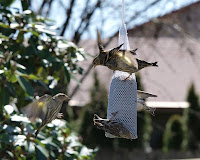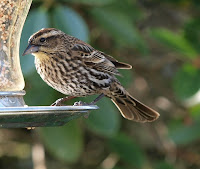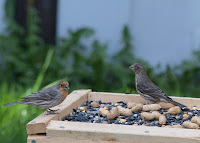This tiny bird is a backyard favorite where it occurs in the Pacific Northwest. It breeds in northern and montane forests, from coast-to-coast across southern Canada, from coastal Alaska to northern California, in the Rocky Mountains south to Arizona and New Mexico, and in the Appalachians to Tennessee. In the winter it can irrupt southward, irregularly visiting backyards in any of the contiguous states in the United States, but very rarely as far south as Mexico.
Exactly what is an irruption, and why do birds do this? John K. Terres, in his 1980 book, The Audubon Society Encyclopedia of North American Birds describes an irruption in this way. He says an irruption is "an irregular migration... often a spectacular mass movement southward in fall and winter of birds that normally live year-round in parts of Alaska and Canada." Red-breasted Nuthatches may do this periodically when their populations are high and their food sources become scarce.
The seeds of pine and spruce cones are a large component of this bird's diet in the winter. They supplement this with insects they glean from the bark as they actively forage over the trunk and limbs, often crawling upside down! Most of the summer food is composed of insects. Thus, the range of this species is restricted to conifers. So, these birds are missing from extensive grasslands in the Pacific northwest and sage lands of the Great Basin. However, they are found in towns throughout these regions where a few conifers have been planted. Their food preference means they are found from sea level shore pines to the alpine fir of treeline on the highest mountains.
If there are conifers in your neighborhood then this little bird will probably find your feeder. They often come to the feeder to take one sunflower seed at a time and fly away with it to a tree branch. They lack the side-to-side chewing ability of the bills of sparrows and finches. Instead, they hold the seed between their feet and pound it open with blows from their sharp bill. They are also attracted to peanut butter and suet cakes.
The larger White-breasted Nuthatch generally prefers deciduous trees. In the ponderosa pine forests of the West, the smaller Pygmy Nuthatch is found. While they all behave the same, and have blue-gray backs and very short tails, neither of these other nuthatches have the rusty breast and white eyebrow. When you see the distinctive coloring and unique behavior of the Red-breasted Nuthatch you will know it!



 Red-winged Blackbird and Yellow-headed Blackbird, Hines, Oregon on 10 May 2008 by Larry Hammond.
Red-winged Blackbird and Yellow-headed Blackbird, Hines, Oregon on 10 May 2008 by Larry Hammond.